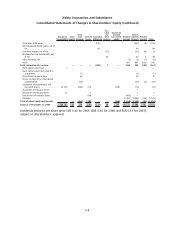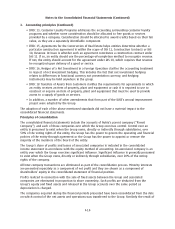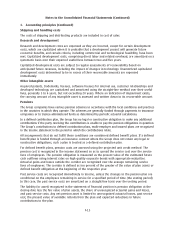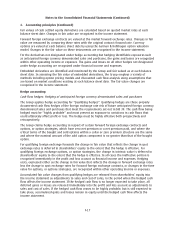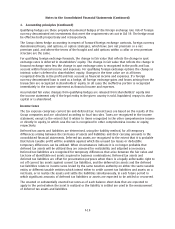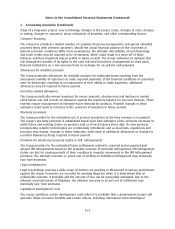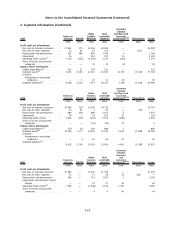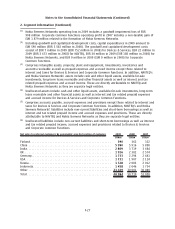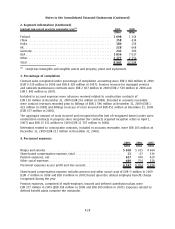Nokia 2009 Annual Report Download - page 192
Download and view the complete annual report
Please find page 192 of the 2009 Nokia annual report below. You can navigate through the pages in the report by either clicking on the pages listed below, or by using the keyword search tool below to find specific information within the annual report.1. Accounting principles (Continued)
Changes in the fair value of any derivative instruments that do not qualify for hedge accounting
under IAS 39 are recognized immediately in the income statement. The fair value changes of
derivative instruments that directly relate to normal business operations are recognized within other
operating income and expenses. The fair value changes from all other derivative instruments are
recognized in financial income and expenses.
Cash flow hedges: Hedging of foreign currency risk of highly probable business acquisitions and other
transactions
The Group hedges the cash flow variability due to foreign currency risk inherent in highly probable
business acquisitions and other future transactions that result in the recognition of nonfinancial
assets. When those nonfinancial assets are recognized in the balance sheet the gains and losses
previously deferred in equity are transferred from equity and included in the initial acquisition cost of
the asset. The deferred amounts are ultimately recognized in the profit and loss as a result of
goodwill assessments in case of business acquisitions and through depreciation in case of other
assets. In order to apply for hedge accounting, the forecasted transactions must be highly probable
and the hedges must be highly effective prospectively and retrospectively.
The Group claims hedge accounting in respect of forward foreign exchange contracts, foreign currency
denominated loans, and options, or option strategies, which have zero net premium or a net
premium paid, and where the terms of the bought and sold options within a collar or zero premium
structure are the same.
For qualifying foreign exchange forwards, the change in fair value that reflects the change in spot
exchange rates is deferred in shareholders’ equity. The change in fair value that reflects the change in
forward exchange rates less the change in spot exchange rates is recognized in the profit and loss
account within financial income and expenses. For qualifying foreign exchange options the change in
intrinsic value is deferred in shareholders’ equity. Changes in the time value are at all times
recognized directly in the profit and loss account as financial income and expenses. In all cases the
ineffective portion is recognized immediately in the income statement as financial income and
expenses.
Cash flow hedges: Hedging of cash flow variability on variable rate liabilities
The Group applies cash flow hedge accounting for hedging cash flow variability on variable rate
liabilities. The effective portion of the gain or loss relating to interest rate swaps hedging variable
rate borrowings is deferred in shareholders’ equity. The gain or loss relating to the ineffective portion
is recognized immediately in the income statement as financial income and expenses.
Fair value hedges
The Group applies fair value hedge accounting with the objective to reduce the exposure to
fluctuations in the fair value of interestbearing liabilities due to changes in interest rates and foreign
exchange rates. Changes in the fair value of derivatives designated and qualifying as fair value
hedges, together with any changes in the fair value of the hedged liabilities attributable to the
hedged risk, are recorded in the income statement within financial income and expenses.
If a hedge no longer meets the criteria for hedge accounting, hedge accounting ceases and any fair
value adjustments made to the carrying amount of the hedged item during the periods the hedge
was effective are amortized to profit or loss based on the effective interest method.
Hedges of net investments in foreign operations
The Group also applies hedge accounting for its foreign currency hedging on net investments.
F18
Notes to the Consolidated Financial Statements (Continued)


